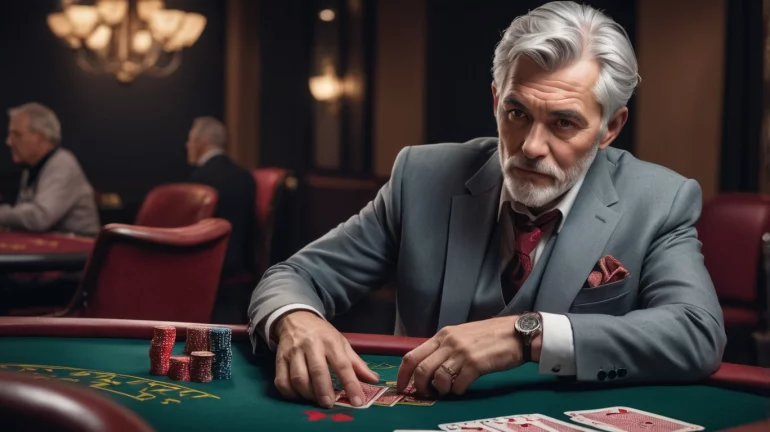Blackjack, a popular casino card game, offers players an intriguing blend of luck and skill. While the game's objective is straightforward – to beat the dealer's hand without exceeding 21 – mastering its strategic elements is key to enhancing your chances.
This article from Casinoz explores the nuances between basic blackjack strategy and optimal blackjack strategy, shedding light on how these approaches can impact your game.

Understanding Basic Blackjack Strategy
Basic blackjack strategy is a mathematically derived set of rules that dictates the best possible action for every player's hand against every dealer's upcard.
It minimizes the house edge to its lowest possible point, assuming a standard set of rules and no other information about the cards remaining in the shoe.
This strategy is typically presented in a chart format, making it accessible even for beginners. For instance, the basic strategy will advise you to hit on a hard 16 against a dealer's 10, or to stand on a hard 12 against a dealer's 5. These decisions are based on probabilities and aim to make the most profitable move over the long run, thereby reducing the casino's advantage significantly, often to less than 1%.
Key elements of basic blackjack strategy include knowing when to hit, stand, double down, split pairs, and surrender (if allowed). Adhering to basic strategy consistently is the foundation for any serious blackjack player. It's the first step towards disciplined play and improving your blackjack odds.
The Concept of Optimal Blackjack Strategy
While basic blackjack strategy is robust and effective, optimal blackjack strategy takes things a step further. Optimal strategy incorporates additional information that goes beyond just your hand and the dealer's upcard. The most prominent method for achieving optimal play is through card counting.
Card counting involves tracking the ratio of high-value cards (10s, J, Q, K, A) to low-value cards (2, 3, 4, 5, 6) remaining in the shoe. When the deck is rich in high cards, the player's advantage increases. In such situations, an optimal strategy player might deviate from the basic strategy. For example, they might hit a hand they would normally stand on, or increase their bet size, to capitalize on the favorable conditions.
Beyond traditional card counting, optimal strategies can also involve more advanced techniques, such as shuffle tracking, or even utilizing sophisticated computer simulations to make micro-adjustments based on highly specific game conditions. However, for most players, optimal strategy primarily refers to intelligent card counting and subsequent strategic adjustments.
Basic vs. Optimal: Key Differences
The fundamental difference lies in the information used to make decisions. Basic strategy relies solely on the current hand and the dealer's visible card. Optimal strategy, particularly through card counting, incorporates knowledge of the cards that have already been played, providing a dynamic assessment of the remaining shoe.
Basic Strategy | Optimal Strategy | |
Information Source | Static chart based on probabilities. | Dynamic assessment of remaining cards (e.g., through card counting). |
Goal | Minimize the house edge to its lowest possible point without external information. | Shift the house edge in the player's favor, potentially achieving a player advantage. |
Complexity | Relatively easy to learn and memorize. | Requires significant practice, mental discipline, and often stealth to avoid detection. |
Risk | Low risk of casino attention. | Higher risk of detection and potential exclusion from casinos (though not illegal). |
Which Strategy Should You Employ?
For the vast majority of blackjack players, mastering basic strategy is the most practical and effective approach. It significantly improves your chances compared to playing by intuition and transforms blackjack from a game of pure chance into one where skill plays a considerable role.
It is the essential foundation for anyone looking to play blackjack seriously.
Optimal strategy, through methods like card counting, is for those who are willing to dedicate substantial time and effort to learn and perfect advanced techniques. While it offers the potential to gain a long-term advantage over the casino, it is a challenging endeavor that requires consistent practice and an understanding of its inherent risks.
| Name | Soft | Return to player | ||
|
|
99.92% | |||
|
|
99.78% | |||
|
|
99.71% | |||
|
|
99.7% | |||
|
|
99.69% | |||
|
|
99.65% | |||
|
|
99.6% | |||
|
|
99.59% | |||
|
|
99.54% | |||
|
|
99.54% |
Conclusion
Whether you choose to stick with basic blackjack strategy or aspire to achieve optimal play through advanced techniques, understanding the mathematical underpinnings of blackjack is crucial.
Basic strategy provides a solid foundation for any player looking to reduce the house edge and enjoy the game more effectively. For those seeking an extra edge, the journey into optimal strategy offers a fascinating, albeit demanding, path to potentially turn the tables on the casino.























